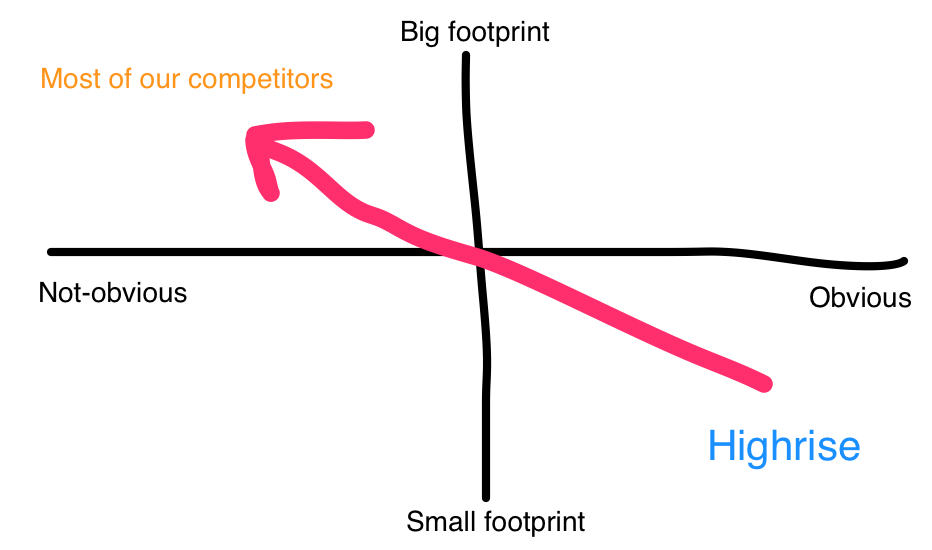I graduated from the University of Illinois (Champaign-Urbana). Marc Andreessen was an alum. That’s where he created the Mosaic web browser which in turn led to creating Netscape. As you can imagine, I had a loyalty to Netscape coming out of school.
But everyone knows how that story turns out. Microsoft won. We were stuck with IE.
IE just got worse and worse. And work was bad about keeping us updated with laptops with enough horsepower, so I was constantly trying to keep my machine running lean.
I remember when a friend showed me something called the Phoenix web browser. I loved it. It was fast. It didn’t make my computer crawl. I was a convert. I used it all day long.
Today Phoenix is called Firefox. And I never open the thing up anymore.
Phoenix/Firefox just got more and more things, and it got slower and slower. It started eating up a ton of memory. All things I was trying to avoid when I first fell in love with Phoenix.
We’ve been doing a series of Jobs to be Done interviews over here at Highrise. After hearing from customers, my brain immediately went into: “We should add this. Jim would want us to build that. Zoe would love it if we made that even better.”
Ryan Singer who was the lead of doing this research for us made a great point (I’ll paraphrase): “You’ve already won these customers. They’re thrilled. You’ve already solved their biggest problems. They aren’t going back to something else. If you keep trying to make it even better, you run the risk of doing just the opposite.”
One of the things that hit us over the head doing these customer interviews is how happy these customers already are.
Many teams create a product that solves a problem well. And they just keep adding more to it. And more. And more. Until it becomes so complicated and bloated the people who were happy to begin with start looking for something that returns to the basics.
Ryan drew this fantastic graph that nails our world.

Highrise already sits in a nice place on this graph. Our tool is obvious, and has a small footprint. It means setup is instant, onboarding new people takes seconds, it’s the fastest thing you can get a team on to start tracking leads and follow-ups.
That solves a few very specific jobs for our customers perfectly:
1) A single sales person inundated with leads whose current system stopped working because of the influx and doesn’t have time to set up something new.
2) Someone who is self-employed and knows they need to grow their business doing sales, but they aren’t sales people. They’re artists, lawyers, party planners. They don’t have time to learn a sales tool.
3) A manager or business owner who needs a system in place immediately for a group of salespeople and staff to handle leads. They have many hats to wear, and learning a sales tool isn’t one of them.
Each one of these jobs came from our customer interviews, and they all mean people need instant solutions that don’t require even a glance at a manual.
Some people need more things from Highrise. No doubt. But if we add many of them, we’d find ourselves in a place with hundreds and hundreds of other competitors.
And the people who were already happiest with us become alienated.
That is so much clearer now that we’ve gotten done with these customer interviews. Our best and happiest customers are already happy. If we keep adding more stuff just to make folks even happier, we run the risk of becoming less obvious and more bloated.
What does that mean for us? Well it doesn’t mean we stop improving the product. But it does help me see how we should focus. We need to keep our eyes set on the basics we already do well and polish any rough edges that still stick out.
For example we already have a great import system. You can import an Excel file, CSV file, vCards. That pretty much means everything. The import system can handle mapping any column to existing or new fields. It’s slick. One problem: it doesn’t support “.xlsx” file types. Which became the default Excel filetype in 2007. There’s a workaround of course to save your spreadsheet as “.xls”. But what a pain. You get to our import screen and many people try to just upload the .xlsx file that’s handy. Only to hit an error screen and realize (or not realize!) they need to go back to Excel to do some more monkeying around. Instead of adding bloat, we can make our imports faster and cognitively leaner.
If you read the History of Mozilla, there’s an interesting part of their ethos:
the first version of Phoenix (later renamed to Firefox) was also released by Mozilla community members that year with the goal of providing the best possible browsing experience to the widest possible set of people.
On the surface that doesn’t sound like a bad goal: make the “widest possible set of people” happy. Who doesn’t want to make the most people happy.
But in reality, you can’t pull it off. Firefox lost me and many of their happiest users because they thought they didn’t do enough for enough people.
At Highrise, that strategy would be our doom.
(I pick on Firefox of old here, but all browsers have been guilty of this, so much so that it might be time to open up Firefox again. I keep searching.)
P.S. If you enjoyed this article, please help spread it by clicking that ❤ below. And if you are interested in more, you should follow my YouTube channel, where I share more about how history, psychology, and science can help us come up with better ideas and start businesses. And if you need a simple system to track leads and follow-ups you should give Highrise a look.


